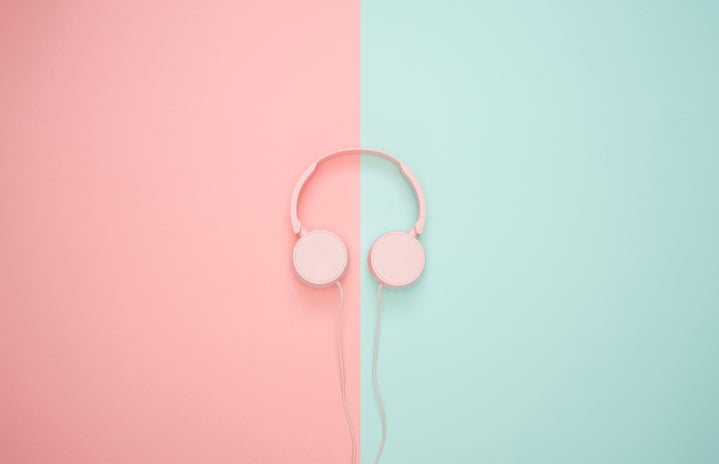Pandemic got you stranded at home scrolling for hours on end? Do you find yourself falling down “rabbit holes” of information? Are you the kind of person who could talk for hours at a party about a weird 70s cult, the latest Marvel news, or other niche topics? Maybe it’s time to share your interests and thoughts with the world.
It is possible to produce quality audio content from your bedroom: and I’ll show you how in just 10 easy steps.
- Deciding the focus of your podcast
-
The first step in your podcast journey is to decide on a focus for your show. The audio medium gives you the freedom to explore any topic, person, or place in time and history, so ask yourself- what interests you?
The key to a successful podcast is passion about the subject. This could mean anything from dictators throughout history to your opinion on the latest fashion runways: as long as you’re impassioned and informed, your listeners will follow. With this freedom comes a market already filled with amateurs and professionals alike. What unique perspective can you provide for your subscribers? What are important issues you don’t hear about often? What does your show do that others don’t?
Remember, you don’t have to limit yourself to one field of study, but your podcast should have an easily distinguishable aesthetic and coverage. Some podcasts like Robert Evan’s Behind the Insurrections focus their coverage on a specific point in history, while other shows like Crime Junkie change topics weekly while still following a general topic. A good rule of thumb from NPR: if you can’t summarize your show in one sentence, you’re likely heading for disaster!
- Formatting
-
Now it’s time to examine the nuts and bolts of your podcast. What will your show look like? Will it be a solo project, one with friends, interviewing professionals, etc? Do you hope to be solely informative, opinion-based, or a combination of both?
It’s also important at the beginning of your journey to settle on a schedule to keep yourself consistent. While podcasts can be a fun side project with friends with no deadlines, successful podcasts tend to upload weekly or bi-weekly content at a continuous pace. Be realistic with your commitments, and make sure you can dedicate enough time each week to research, editing, scriptwriting, interviews, and more. How long will your episodes be? How often will you record and upload?
Do your homework! Listen to other podcast formats for inspiration, and decide the best way to structure your episodes. For example, if you want to start a podcast on your favorite superhero movies, it may be a good idea to structure your show focusing on one film per episode, beginning with a synopsis and transitioning into a critique.
Here’s a tip: even if you hope to capture an unscripted feeling of podcasts like Call Her Daddy, remember to ALWAYS have an outline. Professionals follow guides too!
- Creating the Feel of Your Show
-
A successful podcast tends to have a recognizable feel and “brand” that audiences expect every upload. This includes things like recurring theme songs, intros and outros, episode titles, and more. What kind of environment are you trying to create for your listeners? Are you hoping to inform, or make them feel like they’re sitting with friends? What are some topics you hope to cover week to week? What do you feel is important enough to talk about?
Check out sites like FreeMusicArchive.org to browse thousands of copyright-free music and sounds to give your show a personal touch!
Make a conscious decision about the viewpoint of your show if necessary. Are you approaching topics from a feminist perspective? Maybe relating to personal stories as an immigrant? No matter your voice, creating a consistent tone throughout your episodes will not only bring back viewers but make the scriptwriting process much more manageable.
- Research
-
Time to prep! Depending on the type of podcast, research may be required before each episode. But no matter what the topic is, fact verification is essential. Even if it’s opinion-based, be informed! What you put on the internet is forever.
Ask yourself: what type of materials do I need to prepare for this podcast? Is there enough verified information available to me to be informed? Do I need scholarly articles, public documents, an autobiography, etc? Would my listeners be better informed on this topic if I brought in an expert for an interview?
Some more intensive podcasts like Serial may require you to request public documents, or even contact subjects of interest across the country. Remember to be vigilant, professional, and respectful of subjects and their privacy. Decide for yourself what topics are feasible for you to cover, and which might have too many barriers. And as always, let your listeners know where you got your information from!
- Creating Script/Outline
-
After deciding on a focused tone and topic, it’s time to start writing out your script. If your show is a retelling of historical or modern events, make sure to have your facts and sources verified and available to listeners. For those conducting interviews, make sure to do your homework and come prepared with several questions and follow-ups.
Even shows that don’t demand a fully written script should have a general outline of topics to cover!
- Recording Devices and Equipment
-
By far the biggest barrier for new podcasters is the costs of recording devices and other equipment. But don’t be discouraged– it’s still possible to record high-quality audio at home right from your smartphone!
For new podcasts, try recording using your Voice Memos app or wired headphones with a microphone. Hold a fist up to your mouth and put the microphone behind it -this should generally be how far away you are! For crisper, more clear consonants, considering investing in a pop filter (I got mine from Amazon for just $10) or even using a thick wool sock around your phone to make your own!
For those of you who are ready for the next step in audio quality, external USB microphones like Blue Yeti are a great beginner tool to launch your podcast. It may be good to consider investing in quality over-the-ear headphones, to ensure your podcast sounds as amazing to your listeners as it does to you. Those who are hoping to interview experts or subjects should also consider recording interviews via Zoom for a socially-distanced collaboration!
To edit your audio, I recommend using Audacity, a fantastic free audio editing software available for download right on your computer! For more advanced editing, consider investing in programs like Adobe Audition- if you’re a student, you may even be able to get it at a discounted price.
Remember, online tutorials are your friend! Make mistakes- the first episode of a podcast is never someone’s best. Allow yourself time to work out the mistakes and learn from them.
- Setting Up Your Recording Space at Home
-
While recording at home, the space around you may be the most important factor for a high-quality podcast. Before you press record, make sure that you are seated in a quiet, undisturbed place (I often record in my closet!). The best-sounding audio requires dampening any hard surfaces, so it’s recommended you record surrounded by soft items like pillows or blankets near your mic. NPR recommends making your own “pillow fort” at home, or even throwing a coat over your head! Make sure to capture several seconds of ambient noise before officially recording to check if there are any unwanted noises -for example, air filtration systems or other technology nearby may create background noise you don’t even realize.
Get creative! Sometimes the best memories of making a podcast are made before you even begin speaking.
- Recording Your Podcast
-
Lights, (no camera), action! It’s time to begin recording. I recommend beginning with a few tongue twisters for vocal warm-ups to loosen your voice. Remember your breath control, articulation, and volume, even in a more relaxed podcast setting. These small factors can be the difference between a good podcast and a great one. Make sure everyone is heard on your recording devices, and begin your journey!
Don’t be afraid of misspoken words or other unintentional errors -many are solved post-production in editing, so enjoy the moment. If you’re having fun, odds are your listeners are having fun too! If you have guests or interviewees, be sure to give them a general time limit before beginning to record- this can save you from having to over-edit later on.
- Uploading Your Content
-
Now that your podcast is recorded and edited, it’s time to share your work with the world! Sites like Anchor and Soundcloud can host and distribute your content for a small fee or entirely free, and can upload your work to popular platforms like Spotify and Apple Podcasts. You can even set up optional monetization to get matched with sponsors, monthly donations from listeners, and more. Remember to give your episode a catchy title, and share your hard work with everyone!
- Share and Promote Your Work
-
The best way to kickstart a successful podcast is to promote it online with friends, family, and others. Asking your followers to share your show with just one friend can snowball into a larger audience. Find online forums that share your interests and invite others to listen to your work, or even post a flyer near your local supermarket to raise awareness. The more ears you have, the more your podcast can grow!
Remember, the success of a podcast is not directly linked to the size of its audience: a successful podcast is informative, consistent, and receptive to criticism when needed. And as long as your having fun, odds are your audience is having fun alongside you.
Go forth, and share your passions one episode at a time!



